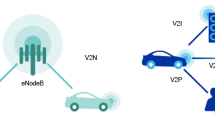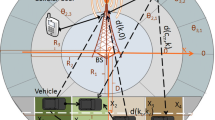Abstract
Device-to-device (D2D) communications in a cellular network can be implemented on vehicular communications. However, high mobilities of vehicles generate fast channel variations in the communications. Channel description has to be specified in the D2D-enable vehicular communications network. In this paper, the vehicle speed and the sampling time are involved to the channel description such that the dynamic information of vehicle is integrated with the channel gain. By doing so, the channel description is more practical. The power control and spectrum sharing problem is formulated in order to maximize the energy-efficiency (EE) of total vehicle-to-infrastructure (V2I) links. It also attempts to ensure reliable communications in a multi-cellular users multi-D2D users frequency division multiple access (FDMA) cellular environment. The reformulated objective function in the fractional form is proved to be quasi-concave, and it can be solved by the Dinkelbach method which requires low computational complexity. In addition, the Hungarian algorithm is used to determine the optimal match of cellular user equipments (CUEs) and V2V pairs. User fairness is further considered under the goal of maximizing overall energy efficiency. Then, the approach of minimum EE maximization is implemented on all V2I links in order to improve system fairness. Finally, the system performance of the proposed scheme is validated by numerical simulations. The results show that the algorithm is effective to improve the energy efficiency and robustness in the dynamic communications environment.










Similar content being viewed by others
References
Ahmed KJ, Lee MJ (2018) Secure LTE-based V2X service. IEEE Internet Things J 5 (5):3724–3732
3rd Generation Partnership Project: Technical specification Group Radio Access Network: Study LTE-Based V2X Service: (Release 14), Standard 3GPP TR 36.885 V 2.0, (2016)
Araniti G, Campolo C, Condoluci M, Iera A, Molinaro A (2013) LTE for vehicular networking: a survey. IEEE Commun Mag 51(5):148–157
Karagiannis G, Altintas O, Ekici E, Heijenk GJ, Jarupan B, Lin K, Weil T (2011) Vehicular networking: a survey and tutorial on requirements, architectures, challenges, standards and solutions. IEEE Commun Surv Tutor 13(4):584–616
Kenney JB (2011) Dedicated short-range communications (DSRC) standards in the United States. Proc IEEE 99(7):1162–1182
Cheng X, Yang L, Shen X (2015) D2D for intelligent transportation systems: a feasibility study. IEEE Trans Intell Transp Syst 16(4):1784–1793
Liu Z, Gao L, Liu Y, Guan X, Ma K, Wang Y (2019) Radio resource management for D2D-based V2V communication. IEEE Trans Ind Inform 16(11):7070–7080
Wang J, Gong Z, Fu J, Chen X, Lin J (2014) A survey on device-to-device communication. J Guilin Univ Electron Technol 16(4):1801–1819
Yu G, Xu L, Feng D, Rui Y, Li GY, Jiang Y (2014) Joint mode selection and resource allocation for device-to-device communications. IEEE Trans Commun 62(11):3814–3824
Feng D, Lu L, Yi YW, Li GY, Feng G, Li S (2013) Device-to-device communications underlaying cellular networks. IEEE Trans Commun 61(8):3541–3551
Doppler K, Rinne M, Wijting C, Ribeiro CB, Hugl K (2010) Device-to-device communication as an underlay to LTE-advanced networks. Modern Sci Technol Telecommun 47(12):42–49
Min H, Lee J, Park S, Hong D (2011) Capacity enhancement using an interference limited area for device-to-device uplink underlaying cellular networks. IEEE Trans Wirel Commun 10(12):3995–4000
Khelil A, Soldani D (2014) On the suitability of device-to-device communications for roda traffic safety. In: IEEE world forum on Internet of Things, pp 224–229
Cheng X, Yang L, Shen X (2015) D2D for intelligent transportation systems: a feasibility study. IEEE Trans Intell Transp Syst 16(4):1784–1793
Ren Y, Liu F, Liu Z, Wang C, ji Y (2015) Power control in D2D-based vehicular communication networks. IEEE Trans Veh Technol 64(12):5547–5562
Feng D, Yu G, Cong X, Yi Y, Li S (2015) Mode switching for energy-efficient device-to-device communications in cellular networks. IEEE Trans Wirel Commun 14(12):6993–7003
Wei L, Hu RQ, Yi Q, Wu G (2016) Energy-efficiency and spectrum-efficiency of multi-hop device-to-device communications underlaying cellular networks. IEEE Trans Veh Technol 65(1):367–380
Cheung KTK, Yang S, Hanzo L (2013) Achieving maximum energy-efficiency in multi-relay OFDMA cellular networks: a fractional programming approach. IEEE Trans Commun 61(7):2746–2757
Yin R, Yu G, Zhang H, Zhang Z, Li GY (2015) Pricing-based interference coordination for D2D communications in cellular networks. IEEE Trans Wirel Commun 14(3):1519–1532
Zhou Z, Xiong F, Chen X (2018) Energy-efficient vehicular heterogeneous networks for green cities. IEEE Trans Inform 14(4):1522–1531
Zhou Z, Gao C, Mumtaz S (2018) Social big-data-based content dissemination in internet of vehicles. IEEE Trans Ind Inform 14(2):768–776
Mei J, Zheng K, Zhao L, Teng Y, Wang X (2018) A latency and reliability guaranteed resource allocation scheme for LTE V2V communication systems. IEEE Trans Wirel Commun 17(6):3850–3860
Liu Z, Xie Y, Yuan Y, Ma K, Chan KY, Guan X (2020) Robust power control for clustering-based vehicle-to-vehicle communication. IEEE Syst J 14(2):2557–2568
Zhao Z, Cheng X, Wen M, Jiao B, Wang C (2013) Channel estimation schemes for IEEE 802.11p standard. Intell Transp Syst Mag IEEE 5(4):38–49
Zhou Z, Yu H, Chen X, Fei X, Li G (2017) Joint relay selection and spectrum allocation in D2D-based cooperative vehicular networks. In: International conference on information and communication technology convergence
Liu Z, Xie Y, Chan K, Ma K, Guan X (2019) Chance-constrained optimization in D2D-based vehicular communication network. IEEE Trans Veh Technol 68(5):5045–5058
Dinkelbach W (1967) On nonlinear fractional programming. IEEE Trans Wirel Commun 13 (7):492–498
bjornson E, Jorswieck EA, Debbah M, Ottersten B (2014) Multi-objective signal processing optimization: the way to balance conflicting metrics in 5G systems. IEEE Signal Process Mag 31(6):14–23
Yu G, Jiang Y, Li GY (2015) Multi-objective energy-efficient resource allocation for Multi-RAT heterogeneous networks. IEEE J Sel Areas Commun 33(10):2118–2127
Douglas BW (2001) Introduction to graph theory-second edtion, Prentice Hall, Upper Saddle River NJ, USA. ISBN 0-13-014400-2
Le L, Li G, Wei X (2017) Resource allocation for D2D-enabled vehicular communications. IEEE Trans Commun 65(7):3186–3197
Acknowledgments
This work is partly supported by National Natural Science Foundation of China under grant 61873223, 61803328 and the Natural Science Foundation of Hebei Province under grant F2019203095.
Author information
Authors and Affiliations
Corresponding author
Additional information
Publisher’s note
Springer Nature remains neutral with regard to jurisdictional claims in published maps and institutional affiliations.
Appendices
Appendix A
In this section, we prove that the fraction objective function is quasi-concave. When the nature of the quasi-concave problems considered, the numerator and the denominator of objective function should be concave. Obviously, the denominator is concave, since it is a linear combination of the positive power variable and the positive power of circuit. Therefore, we focus on proving the numerator is concave. The proof is given as follows:
The second derivative of the molecular part of the objective function is less than or equals to zero. This issue is concave. An iterative algorithm, Dinkelbach’s method, can be used to solve a qusi-concave problem.
Appendix B
Assuming that hk,k is an independent random variable which is in the complex Gauss distribution \(\mathcal {C}\mathcal {N}{(0,1)}\), and hk,k can be expressed as a complex variable with a real part and a imaginary part as,
where x and y are identically distributed in \(\mathcal {C}\mathcal {N}{(0,\frac {1}{2})}\); x is independent to y. To be specified, the probability density functions of x and y are given as
Hence, the combined probability density distribution function of x and y can be formulated as
The modulus length of hk,k is given as
If |hk,k| = 0, f(|hk,k|) = 0. If |hk,k| > 0, the probability distribution function \(F_{H_{k,k}}(|h_{k,k}|)\) can be formulated as
Supposing that \(x = r{\cos \limits } t\), \(y = r{\sin \limits } t\) (0 ≤ r ≤|hk,k|), the probability distribution function F(|hk,k|) can be rewritten as
Therefore, the density function of |hk,k|2 is
Rights and permissions
About this article
Cite this article
Liu, Z., Han, X., Xie, Ya. et al. Energy-efficiency maximization in D2D-enabled vehicular communications with consideration of dynamic channel information and fairness. Peer-to-Peer Netw. Appl. 14, 164–176 (2021). https://doi.org/10.1007/s12083-020-00970-x
Received:
Accepted:
Published:
Issue Date:
DOI: https://doi.org/10.1007/s12083-020-00970-x




